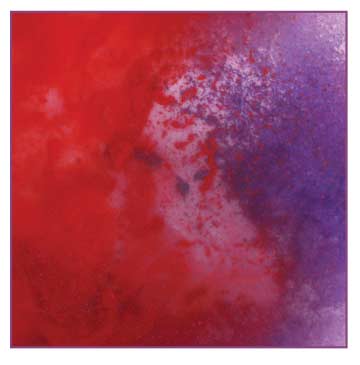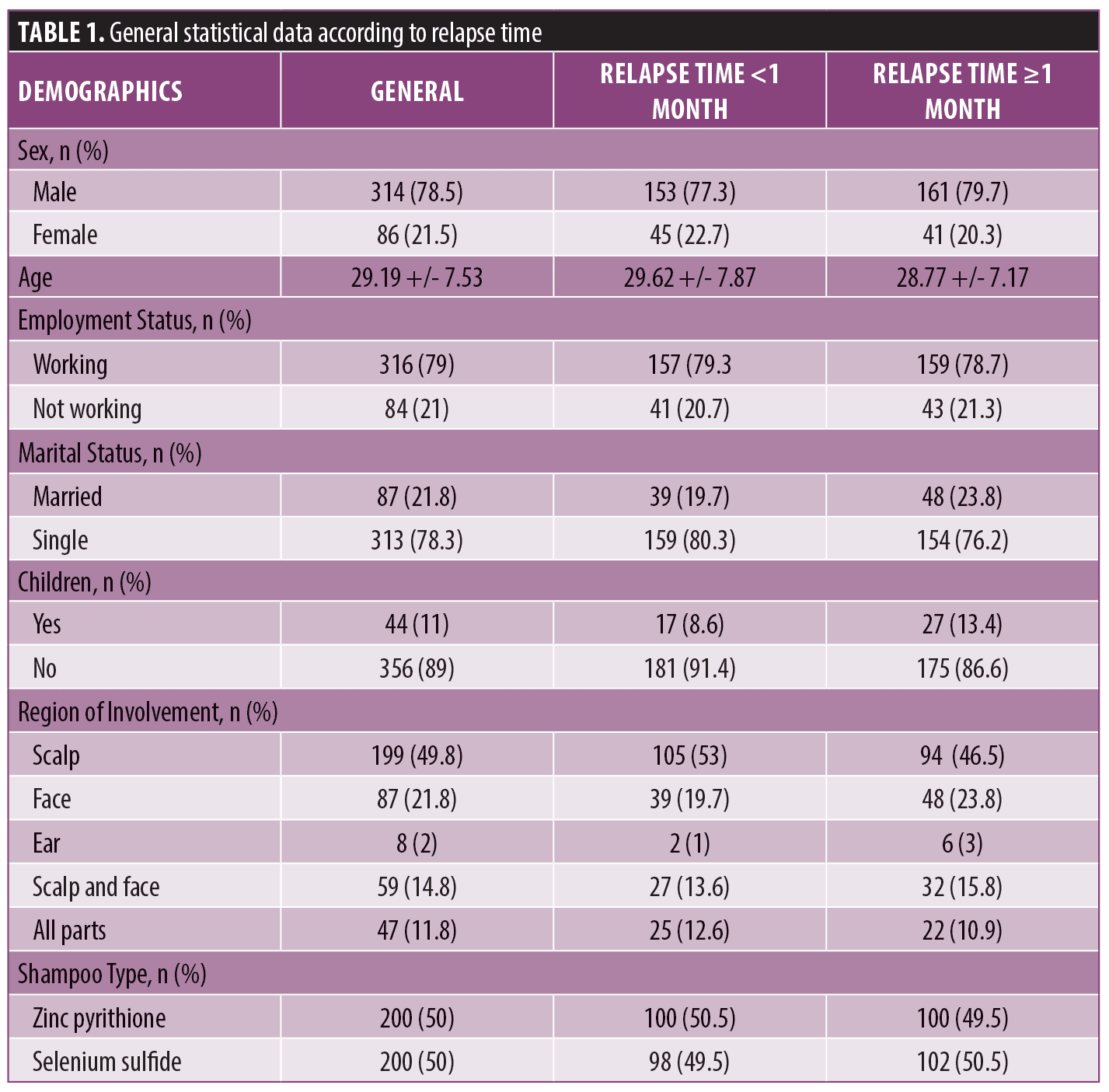 J Clin Aesthet Dermatol. 2023;16(5):40-42.
J Clin Aesthet Dermatol. 2023;16(5):40-42.
by Sabir Hasanbeyzade, MD
Dr. Hasanbeyzade is with the Department of Dermatology and Venerology at Medicana International Hospital in Ankara, Turkey.
FUNDING: No funding was provided for this article
DISCLOSURES: The author reported no conflicts of interest relevant to the content of this article.
ABSTRACT: Background. There are studies in the literature on zinc pyrithione and selenium disulfide containing shampoos for the treatment of seborrheic dermatitis, but we have not been able to find a study that clearly evaluates the duration of relapses.
Objective. This retrospective chart review investigated disease relapse times in patients with seborrheic dermatitis who achieved remission with treatment and continued maintenance therapy using zinc pyrithione or selenium disulfide containing shampoo.
Methods. Records from a total of 400 patients were reviewed, with 200 patients having used zinc pyrithione shampoo and 200 patients having used selenium disulfide shampoo.
Results. There was no statistically significant difference between the patients who relapsed in less than a month and patients that relapsed after more than a month in terms of product used in maintenance therapy (p=0.841).
Discussion. In our study, we found that zinc pyrithione and selenium disulfide shampoos used in maintenance therapy did not have significantly different effects on relapse times in patients who achieved remission after appropriate treatment.
Keywords: Seborrheic dermatitis, zinc prythione shampoo, selenium disulfide shampoo
Seborrheic dermatitis (SD) which usually affects the glabellar area, proximal nasolabial area, inner malar area, the inner ear and the back of the ear, scalp, but rarely the body folds, such as umbilicus, axillary, inguinal and genital regions, is a chronic inflammatory disease that displays periods of exacerbation and regression, characterized by squamous lesions on an erythematous background which can also be accompanied by itching.1–4 In particular, there may be itching with scalp involvement.5,6 Malassezia furfur has been identified as a factor, and there is more cultural positivity, especially in the involvement of the scalp.7,8 Stress, seasonal transitions, sweating, increased sebum production, immunosuppression status, the presence of neurological and psychiatric diseases, hepatitis C, and the use of certain medications can trigger and aggravate the disease.1,9–16 The prevalence rate has been reported at 1 to 3 percent.17,18
This retrospective chart review investigated disease relapse times in patients with seborrheic dermatitis who achieved remission with treatment and continued maintenance therapy using zinc pyrithione or selenium disulfide containing shampoo.
Methods
The study was approved by the non-clinical research ethics committee of Medicana International Ankara Hospital. The study was conducted retrospectively by scanning patient files, therefore patients did not sign an informed consent form. Four hundred patients, aged 18 years or older, who were diagnosed with SD in the outpatient clinic between February 2021 and October 2021 were included. Those who had a diagnosed rheumatological disease, used any topical product other than the SD treatments, and/or those who were under systemic corticosteroid treatment were not included in the study.
Moderate to strong corticosteroid creams or lotions were used twice a day for an average of three weeks to treat all of the patients included in the study. Following clinical improvement with treatment using the corticosteroids, the included patients used zinc- or selenium disulfide-containing shampoo as maintenance treatment, and the effects of zinc pyrithione and selenium disulfide-containing shampoos on lesion-free time were investigated. Patients used the zinc or selenium disulfide shampoo three times per week; each time the shampoo was left on the scalp for 3 to 5 minutes, and then rinsed. There was a single grader (the author). Patients attended monthly follow-up visits for five months.
The data were analyzed using the SPSS 25 program and statistical analyses were performed. Mean and standard deviation were used for continuous variables, and number and percentage were used for discrete variables. P values less than 0.05 were considered significant. The difference between groups with continuous variables was evaluated with the Kolmogorov-Smirnov test for compliance with normal distribution. The Kruskal-Wallis test, which is one of the non-parametric tests, was used to determine whether there was a statistically significant difference between three or more independent groups that included continuous variables and did not comply with the normal distribution. Mann-Whitney U test was used to determine whether there was a difference between the two groups that did not fit the normal distribution. A chi-square test was used to determine whether there was a statistically significant difference between independent groups with discrete variables.
Results
The mean age of the 400 patients included in the study was 29.19 +/- 7.53. Of these patients, 314 (78.5%) were male and 86 (21.5%) were female. While these numbers were 29.62 +/- 7.87, 153 (77.3%), 45 (22.7%) respectively in the group whose disease recurred in less than a month, 28.77 +/- 7.17, 161 (79.7%), 41(20.3%) in the group whose disease recurred in one month or more. While the number of patients with a relapse period earlier than a month was 198 (49.5%), the number of patients whose disease relapsed after one month was 202 (50.5%). Patient demographic information and detailed statistical information about the groups separated according to the relapse times are shown in Table 1. The patients were divided into five groups according to the localization of symptoms: scalp, face, ear, scalp and face and all parts.

There was no statistically significant difference between the group whose disease relapsed in less than a month and the group that relapsed after a month or more in terms of sex, age, employment status, marital status, whether or not they had children, region of involvement, and product used in maintenance therapy (p-values, respectively: 0.554, 0.275, 0.887, 0.324, 0.127, 0.391 and 0.841).
Discussion
The average age and sex distribution found in our study coincide with the accepted age and sex information of seborrheic dermatitis. SD is more common in males and peaks in the first months of life, at puberty or at the age of adulthood.4,17
We could not find a statistically significant difference between the type of shampoo and the recurrence times. We did not find any information about recurrence times in studies related to zinc pyrithione and selenium disulfide shampoo in Pubmed.19-24
Conclusion
Based on the results of our study, we conclude that neither zinc pyrithione nor selenium disulfide shampoos demonstrate a superior effect on time to disease recurrence when used as maintenance treatment for patients with seborrheic dermatitis who have achieved remission with topical corticosteroids.
References
- Araya M, Kulthanan K, Jiamton S. Clinical characteristics and quality of life of seborrheic dermatitis patients in a tropical country. Indian J Dermatol. 2015;60(5):519.
- Berk T, Scheinfeld N. Seborrheic dermatitis. Pharm Ther. 2010;35(6):348.
- Stefanaki I, Katsambas A. Therapeutic update on seborrheic dermatitis. Skin Ther Lett. 2010;15(5):1–4.
- Schwartz RA, Janusz CA, Janniger CK. Seborrheic dermatitis: an overview. Am Fam Physician. 2006;74(1):125–130.
- Halder RM, Nootheti PK. Ethnic skin disorders overview. J Am Acad Dermatol. 2003;48(6 Suppl):S143–S148.
- Del Rosso JQ. Adult seborrheic dermatitis: a status report on practical topical management. J Clin Aesthetic Dermatol. 2011;4(5):32–38.
- Kastarinen H, Oksanen T, Okokon EO, et al. Topical anti-inflammatory agents for seborrhoeic dermatitis of the face or scalp. Cochrane Database Syst Rev. 2014;5:CD009446.
- Ortonne JP, Lacour JP, Vitetta A, et al. Comparative study of ketoconazole 2 % foaming gel and betamethasone dipropionate 0.05 % lotion in the treatment of seborrhoeic dermatitis in adults. Dermatol Basel Switz. 1992;184(4):275–280.
- Misery L, Touboul S, Vinc¸ot C, et al. Stress and seborrheic dermatitis. Ann Dermatol Venereology. 2007;134(11):833–837.
- Gupta AK, Madzia SE, Batra R. Etiology and management of Seborrheic dermatitis. Dermatol Basel Switz. 2004;208(2):89–93.
- Gupta AK, Bluhm R. Seborrheic dermatitis. J Eur Acad Dermatol Venereol JEADV. 2004;18(1):13–26 (quiz 19–20).
- Naldi L, Rebora A. Clinical practice. Seborrheic dermatitis. N Engl J Med. 2009;360(4):387–396.
- Choeng WK, Yeung CK, Torsekar RG, et al. Treatment of seborrhoeic dermatitis in Asia: a consensus guide. Skin Appendage Disord. 2015;1:187–196.
- Cribier B, Samain F, Vetter D, et al. Systematic cutaneous examination in hepatitis C virus infected patients. Acta Derm Venereol. 1998;78(5):355–337.
- Barba A, Piubello W, Vantini I, et al. Skin lesions in chronic alcoholic pancreatitis. Dermatologica. 1982;164(5):322–336.
- Tegner E. Seborrhoeic dermatitis of the face induced by PUVA treatment. Acta Derm Venereol. 1983;63(4):335–339.
- Johnson BA, Nunley JR. Treatment of seborrheic dermatitis. Am Fam Physician. 2000;61(9):2703–10, 2713–2714.
- Clark GW, Pope SM, Jaboori KA. Diagnosis and treatment of seborrheic dermatitis. Am Fam Physician. 2015;91(3):185–190.
- Piérard-Franchimont C, Goffin V, Decroix J, et al. A multicenter randomized trial of ketoconazole 2% and zinc pyrithione 1% shampoos in severe dandruff and seborrheic dermatotis. Skin Pharmacol Appl Skin Physiol. 2002;15(6):434–441.
- Barak-Shınar D and Green LJ. Scalp Seborrheic Dermatitis and Dandruff Therapy Using a Herbal and Zinc Pyrithione-based Therapy of Shampoo and Scalp Lotion. J Clin Aesthet Dermatol. 2018;11(1):26–31.
- Borda LJ, Perper M, Keri JE. Treatment of seborrheic dermatitis: a comprehensive review. J Dermatolog Treat. 2019;30(2):158–169.
- Melhorn S. Use of salicylic acid oils on the scalp. Hautarzt. 2017;68(3):248–249.
- Massiot P, Clavaud C, Thomas M, Ott A, et al. Continuous clinical improvement of mild-to-moderate seborrheic dermatitis and rebalancing of the scalp microbiome using a selenium disulfide–based shampoo after an initial treatment with ketoconazole. J Cosmet Dermatol. 2021;00:1–11.
- Danby FW, Maddin WS, Margesson LJ, et al. A randomized, double-blind, placebo-controlled trial of ketoconazole 2% shampoo versus selenium sulfide 2.5% shampoo in the treatment of moderate to severe dandruff. J Am Acad Dermatol. 1993;29(6):1008–1112.

